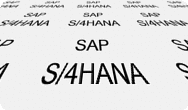S/4 HANA seen and heard a lot of it! What matters most, is there a value addition? Is it worth my monies? Read further to know exactly what you want to know…
HANA is a new dB technology based on the concept of in-memory computing. It is different from the traditional dB’s in the sense that is predominantly columnar based combined with row based. This allows reduced data foot print and much faster OLAP and OLTP processes.
What does S/4 HANA really mean?
S Next Generation Revolutionary Business Suite
4 Fourth generation ( 1- R2, 2-R3, 3-ERP)
HANA High Performance Analytic Appliance.
In the early days of its development it was also called as Hasso’s New Achitecture. Prof. Hasso Plattner was the think tank behind this new dB design. Dr. Vishal Sikka has contributed significantly in the designing and development of HANA.
Background
Key drivers of traditional ERP’s are based on single core processors (CPU) and data is stored in Hard Drive Disks (HDD). The speed at which data is stored and retrieved with this mechanism is slow and expensive. With the ever increasing data size and advent of disruptive technologies, a new dB was the need of the hour.
The need of the hours was a revolutionary dB. Hence, came HANA into existence in 2010-11. HANA dB is driven by multi core processors and data stored in SSD’s (Solid State Disks). This combination delivers OLAP and OLTP at break neck speed and also comes at cheaper price that one could possible imagine. The architecture is based on the concept of columnar data storage. Colgate was the first company where HANA was deployed as a replacement to the traditional ERP.
Here’s why S/4 HANA, from the Director – Product Marketing of S/4 HANA
Howz the IT benefited from HANA? learn it from the Director – Product Marketing of S/4 HANA
Key Features
Parallel Operators – The development of this technology began from scratch and the conceptual dB design was based on the mantra to utilize the full potential of the available processors. This not only increases the speed of operations but also the depth of accessibility. Thereby allowing prompt and on the fly business decision making.
SOAR (Sales Order Allocation and Rescheduling) would be an apt example which is based on HANA. The performance increases exponentially.
Here’s what the CIO of Under Armour has to say…
Row & Columnar Storage – Rows are used for faster transaction processing and Columns primarily used for accessibility and analytics. HANA does about 3.5 Billion integer scans per second per core. Traditional EPR’s scan data row-wise and thus results in slower data processing. HANA uses a combination of both the attributes-rows & columns for faster processing of transactions and analytics.
Latch Free – The concept of locking is a thing of the past! This is addressed by way of a single function, “INSERT ONLY” to the dB (row/column). The other function being “READ ONLY”.
Data Compression – Huge Data compression is achieved since the basic storage is columnar. This allows storing data in an optimized fashion by creating dictionaries on a large volume of data. The reduced data foot print not only reduces the TCO but enables faster processing.
Compatibility – S/4 HANA can run not only on premise but also on cloud and so supports multiple tenancy. It comes with SAP Fiori UX that enables it to run on multiple devices – mobile, PC, tabs.
Here’s a technical insight from the experts at SAP – Chris and Eric …
All FAQ’s on SAP S/4 HANA by SAP
S/4 HANA Use Cases and Business Benefits

